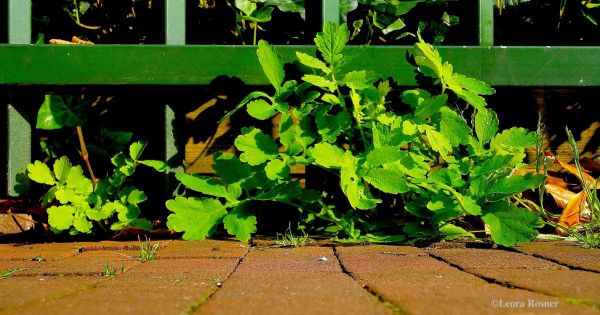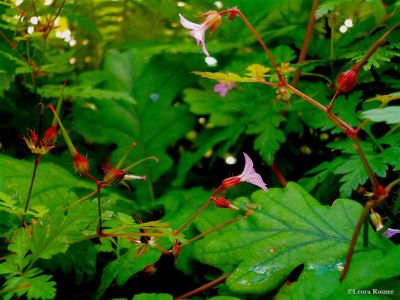
Walking with Weeds
Leora Rosner
Now that summer has reached this shore, albeit for a mere few days, come and walk with me. Let’s see what’s growing along the sidewalks, streets, fences and empty lots. Let’s look at the wild potential in greening and cooling cities. This past summer, here in Amsterdam (Netherlands), most days and nights were filled with powerful downpours and long rain showers lasting hours, something we are seeing worldwide at a much greater and devastating rate due to climate change or as the phenomenon is also called global warming.
The wild potential I’m talking about is not just the planting of trees or green facades and rooftops (which we most desperately must continue doing) or manicured gardens. Even city trees, here in Amsterdam, have well manicured ground area because the weeds make things look “messy” when, in fact, those same weeds help to keep trees healthy! It is allowing the wild growth of those plants we call weeds that have been deemed destructive, despicable, pernicious, ugly and invasive. They must be destroyed, poisoned, eradicated, exterminated and annihilated. Well, according to all the chemical companies. And the consumer has been duped into buying their products. Weeds, a most unfortunate name with an equally unfortunate negative connotation. Those weeds were there long before mankind débuted on this particular stage we call earth. Ralph Waldo Emerson said, „A weed is simply a plant whose virtues have not yet been discovered.“ The wild plants were there and still are here creating a protective balance with natural areas, revitalizing the soil and warding off insects that would normally be detrimental to the plants we consider not to be weeds including the crops we grow for food. Richard Mabey in his book, „Weeds“ states that weeds are the prototypes of most of the plants that keep us alive!“

A few years ago in my own quest for a healthy balanced garden on my balcony I decided to “let” it go. Initially I had only domesticated plants and trees and enormous problems with bug infestations all eager to chew and digest everything in sight. Adamant in not using pesticides, I tried other methods but continued to lose the battle, well, the entire war. The only thing left was to leave well enough alone and see what would happen once it all went wild. Birds visited, rain fell, the wind blew, seeds sailed into my little green port and dug in. The following spring buds began popping out of every pot quite happy to play second fiddle with the original occupants. The wild plants, marigolds, Roberts Geranium, wild rocket, foxglove and more, began blooming displaying a colorful invitation to butterflies, bees, ladybugs and other pollinating insects. Various birds visited as well, pigeons, tits, ravens, sparrows and blackbirds. The voracious bugs were still there but their numbers were diminishing. My plants and trees were not being consumed like a turkey dinner. Another year passed and the wild plants emerged in greater abundance in perfect balance and in perfect harmony with the rest and the unwanted guests were gone. My original occupants are faring much better then ever before. Those “bad” weeds saved my balcony garden from destruction and not an ounce of pesticide was used.
Outside, here on the streets I would even dare to say weeds are also city savvy. Most weeds seem to know where to grow. They hug the buildings creating wild gardens, they love to grow around poles and grow in parking places close to the sidewalk and along the lines marking the parking spot and they love to grow around the trees.

Although they are city dwellers they continue to deposit nutrients into the soil, 80% of a weeds nutrients are gleaned from the air! Not only the CO2 they soak up but also airborne nutrients as well as from water, cosmic and solar energy.
Weeds can tell us what is wrong with the soil and what is right with the soil. They are the immune system working for all plants. Ehrenfried Pfieffer said, „Weeds are specialists. They survive under circumstances where our cultivated plants cannot stand up against nature’s caprices. Weeds resist conditions, such as drought, acidity of soil, lack of humus and mineral deficiencies. They are witness to man’s failure to master the soil. They indicate our errors and nature’s corrections.“ Nature knows what it’s doing and the inclusion of weeds in her grand collection indicate just how intimate and intricate her knowledge is. Cocannouer recalls a story in his “Weeds Guardians of the Soil” of seeing an old woman in southern China creeping along the rocks and steep banks in search of specific weeds. On close inspection Cocannouer saw that there were 2-3 types of thistle, a plant similar to the poppy, milkweed and spurge. The weeds or rather wild plants were a treasure trove that would feed the soil and feed the crop that would feed her.
To give you an idea what weeds, in fact, do:
1. Particularly important with regard to trace elements weeds bring minerals, which have been depleted in the topsoil, up from the subsoil to the topsoil making them available to crops.
2. Weeds used in crop rotations break up hardpans (hardened impenetrable layer, typically of clay, occurring in or below the soil, impairs drainage and plant growth) allowing crop roots to feed deeply.
3. They fiberize and condition the soil. This provides the perfect environment for important plant and animal life allowing for healthy productive soil.
4. They are soil diagnosticians. Certain weeds will grow when particular deficiencies occur.
5. Weeds are deep divers and feeders. Through soil capillarity they enable the less hardy, surface feeding crops to withstand drought. The crop alone could not do this.
6. When used as a companion crop weeds enable domesticated plants to get the otherwise unavailable nutrients.
7. Nutrients that would be blown, washed away or leached from the bare ground are stored by weeds keeping them readily available.
8. Weeds are good to eat, not just for animals but also for people. Lambs quarters, for example, when cooked taste similar to spinach.
The following illustration show how deep the roots of wild plants dive compared to bluegrass:

In short weeds and their deep diving roots are determined explorers in a rich world unknown to other plants and crops. Once the weeds have reached their goal they pump nutrients back to the surface. They fiberize the soil, create water reservoirs, whereby water is moved up along the outside of the weeds roots up to the surface providing thirsty plants and crops with water. This is the reason why plants or crops in partnership with weeds can survive dry periods and even droughts as opposed to those without weeds. The idea of wild gardens and being called that was coined by the Irish gardener William Robinson. He suggested that the undomesticated beauty of weeds might have a place in what he called our outside rooms. Since we are walking in one of my outside rooms I can show you just such a wild garden that sprang up just days after near torrential downpours.

To some people this looks an unlikely spot for a garden full of domesticated plants. Very few people walk on this side of the street and cars are parked with their noses hovering above the sidewalk. However, pulling a row of bricks to the bare soil and allowing wild plants to grow there provides a strip of green that doesn’t need any special care or attention. For the occasional pedestrian there is a feast of color for the eyes and they help the urban environment as well. Imagine any city with its’ enormous facades made of brick or stone, steel and glass. Now imagine wild gardens along all of those buildings and the difference it would make, again for the environment and people regain a sense of calmness simply because the hard lines have been softened. The literal edge is off, one can relax a bit and smell the flowers. Cities will become safe apian homes to healthy bee colonies. We will be witness to an increase in the butterfly populations as well. It’s a win-win situation. Our weeds are meant to be the companions of our domesticated plants. Let us help nature do her work and provide space in our outside rooms for wild gardens. Numerous parties will profit and so will we!
Photos: © Leora Rosner
